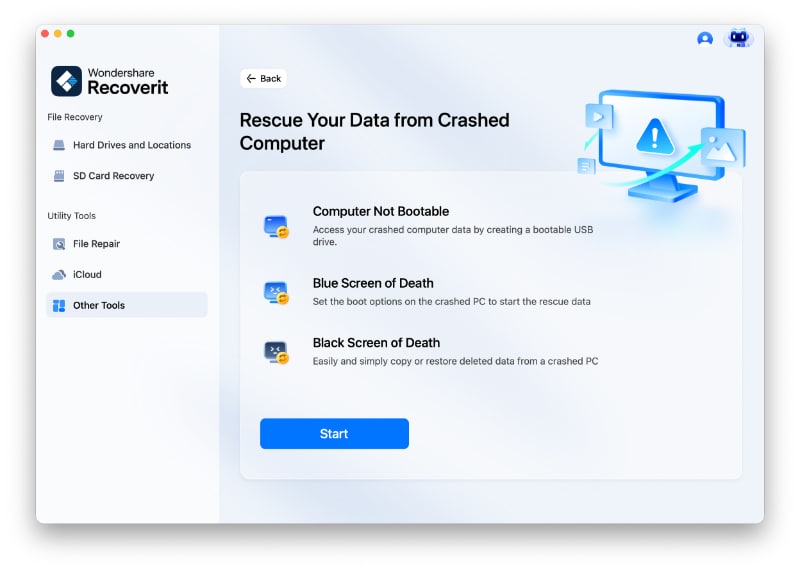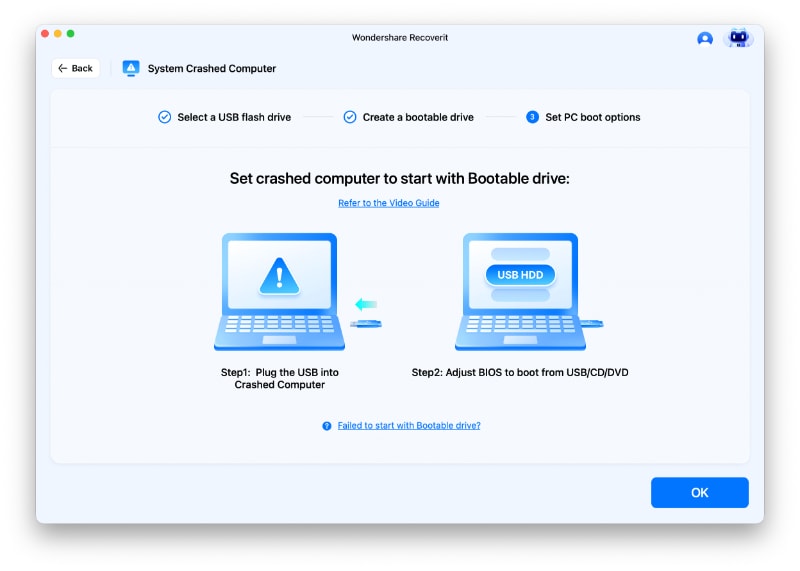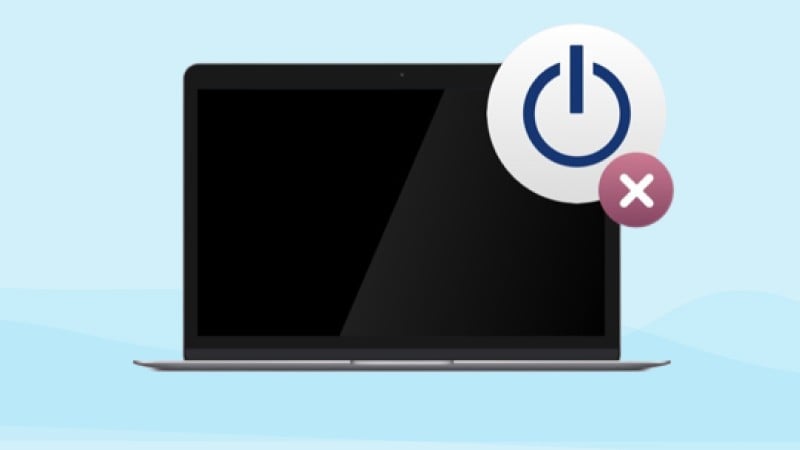I left my Mac on charging for 3 hours as I had to get out for a while. After I come back Mac isn't switching on. Why is my MacBook Pro not turning on? How do you fix a Mac that won't turn on?
Pressing the power button on your MacBook and getting no response is a stressful experience. When your MacBook will not turn on—no startup chime, no fan noise, no display activity—it's easy to fear the worst. However, this common issue is often caused by a simple power-related problem that you can resolve yourself.
This guide is here to walk you through the troubleshooting process step-by-step. Before you schedule a repair, we'll cover the most common reasons your Mac laptop isn't powering on and provide you with eleven proven methods to fix it. We'll also show you how to recover data if your MacBook is unbootable.
Table of Content
-
- Disconnect All Peripherals
- Use the Keyboard Sequence
- Reset the T2/SMC Chip
- Do a T2 Security Chip Firmware Restore
- Do a Hard Restart
- Check if Your RAM Works
- Boot a MacBook Pro in Safe Mode
- Reset NVRAM and PRAM
- Run Disk Utility in Recovery Mode
- Reinstall macOS
- Contact Professional Macbook Repair Services
Common Reasons for a MacBook Not Turning On
Some MacBook users have reported their laptops won't turn on. That happens occasionally and is no cause for alarm. You can fix your MacBook in several ways, depending on why it won't turn on.
The most common reasons for a Macbook Won't Turn On are:
- Insufficient power - If your MacBook has a faulty battery or your power cable is damaged, you won't be able to turn it on.
- Hardware issues - If your display, keyboard, RAM, PRAM, NVRAM, T2 chip, or other hardware is faulty, your MacBook won't power on.
- Software problems - Temporary bugs, glitches, and other software hiccups can sometimes cause your MacBook not to power on. Thus, fixing them can be the solution.
- Hard drive issues - If the disk with your macOS installation is corrupted or damaged, you won't be able to start your MacBook.
- Faulty macOS - Viruses and corruption can cause operating system problems. If that happens, your MacBook won't start up.
MacBook Will Not Turn On - Top 11 Advanced Fixes
Once you've established the cause of your Macbook won't turn on and checked all the physical components, you can start fixing it. We've prepared the top 11 fixes with step-by-step instructions to help you repair your MacBook Pro or MacBook Air and make it usable again. If you are using an iMac, refer to the guide for fixing an iMac that's not turning on.
Fix 1: Disconnect All Peripherals
If you have connected many external accessories to your MacBook, the SMC (System Management Controller) will take longer to power on or simply won't be able to do it. Thus, disconnect all peripherals and try turning it on again.
Since your MacBook will suffer from the excess current due to the peripherals, the SMC will prevent it from switching on as a safety measure. Disconnecting all accessories will allow your MacBook to turn on.
Fix 2: Use the Keyboard Sequence
If you notice that your MacBook screen isn't dead and turns on but gets stuck on the Black Screen of Death, it may appear as if it's not turning on. However, you can try fixing that by using the keyboard sequence.
If your MacBook is stuck on the Black Screen of Death, it can still perform actions and commands even if you can't see them. Follow these steps to fix your MacBook by using the keyboard sequence:
- Press the Power button.
- Press the S key to send your MacBook to sleep.
- Hold the Power button for four seconds to force a shutdown.
- Once it powers off, wait 16 seconds and turn your MacBook on again by pressing the Power button.
Fix 3: Reset the T2/SMC Chip
The SMC handles crucial components on your MacBook. If the SMC is having problems managing your display or other essential parts, your Macbook won't turn on. Thus, resetting the SMC on your MacBook can resolve the problem.
However, if your MacBook has an M1 processor, it doesn't have the SMC, so you can't perform the reset on such laptops.
Follow these steps to reset the SMC on a MacBook with a T2 chip:
- Turn off your MacBook.
- Press and hold the Power button for ten seconds.
- Press the Power button again after a few seconds to turn on your MacBook.
Follow these steps to reset the SMC on a MacBook without a T2 chip:
- Turn off your MacBook.
- Unplug the power cable.
- Press and hold the Shift + Option + Control + Power keys for ten seconds.

- Plug in the power cable and turn on your MacBook.
Fix 4: Do a T2 Security Chip Firmware Restore
The T2 security chip is a multifunctional chip with an integrated SMC chip. If the T2 chip is faulty, it won't respond to the Power button, meaning you won't be able to turn on your MacBook. Fortunately, when you update your macOS, the installation comes with device firmware updates (DFU).
These updates allow firmware to update and operate smoothly. However, your T2 chip firmware can get corrupted if the update fails. Follow these steps to do a T2 security chip firmware restore:
- Get a working MacBook and visit the official Apple website to download the app Apple Configurator 2.
- Open the app on your working MacBook.
- Connect it to the MacBook that won't turn on using a USB-C cable and the Master port.

- Press the Power button on the working MacBook, then press and hold Control + Options + Shift (without releasing the Power button) until you see the DFU text on the screen.

- Release the four keys at the same time. Your MacBook that won't turn on is in DFU mode now.
- The DFU device on your MacBook that won't turn on will appear on your working Mac, so select it and click Action.
- Choose Advanced from the drop-down list and click Revive Device.

- That will download the correct firmware for your T2 security chip, so wait for the installation to complete. It will automatically turn on your MacBook.
Fix 5: Do a Hard Restart
If your MacBook won't turn on, you can't restart it as usual. However, you can do it forcibly. Regardless of the MacBook model, a hard restart includes the same steps.
Follow these prompts to perform a hard restart on your MacBook:
- Press and hold the Power button until your MacBook boots.
- Press the Control + Command + Power buttons to restart your MacBook forcibly.

Fix 6: Check if Your RAM Works
Your MacBook won't turn on if your RAM doesn't work. To check if your RAM works correctly, turn your MacBook on and listen for beeps:
- Repeating beeps - faulty RAM;
- One beep every five seconds - RAM not detected;
- Three beeps every five seconds - RAM didn't pass a data integrity check.
If your RAM is faulty, you must replace it to fix the problem. If your laptop doesn't detect it, open your MacBook and readjust your RAM to install it correctly. If your RAM didn't pass the data integrity check, see if you've installed it properly or consider replacing it with a different brand.
Fix 7: Boot a MacBook Pro in Safe Mode
Software issues or corrupted disk files can prevent a MacBook from turning on. You can fix this problem by booting your Mac in Safe Mode. Depending on the model, you can boot a MacBook in Safe Mode in two ways.
Follow these steps to boot your Intel-based MacBook in Safe Mode:
- Turn off your MacBook.
- Leave it off for 20 seconds, then turn it back on.
- Press and hold Shift while it's turning on.
- Once the login window appears, log into your Mac.
Follow these steps to boot your MacBook with Apple silicon in Safe Mode:
- Turn off your MacBook.
- Press and hold the Power button until you see the Loading startup options.
- Select a volume, then press and hold the Shift key.
- Click Continue in Safe Mode.
Once you put your MacBook into Safe Mode, let it finish booting. That may take a few seconds or minutes. Afterward, restart your MacBook to exit Safe Mode. Then, power it on again by pressing the Power button.
Fix 8: Reset NVRAM and PRAM
NVRAM and PRAM are tiny bits of memory storing specific settings for your MacBook. However, they can sometimes store corrupted files. If that happens, it can lead to your MacBook's inability to start up or cause the MacBook screen to flicker. Thus, resetting PRAM or NVRAM can resolve the problem.
Follow these steps to reset your MacBook's PRAM or NVRAM:
- Turn off your MacBook.
- Restart it by pressing the Power button.
- While it's starting up, long-press Command . Option + . + ..

- Keep holding these keys until your MacBook restarts, which will automatically reset your PRAM or NVRAM.
Fix 9: Run Disk Utility in Recovery Mode
Recovery Mode is a built-in recovery system Mac provides its users. Thus, you can boot your MacBook into Recovery Mode to fix the problem of its inability to boot. If your MacBook has issues turning on due to a faulty or corrupted hard drive, you can use Disk Utility in Recovery Mode to fix it.
Follow these steps to run Disk Utility in Recovery Mode:
- Press and hold the Power button for ten seconds.
- Once you release it, press it again with the Command and . keys.

- Hold the keys until the macOS Utilities window appears.

- Select your startup disk in Disk Utility. It's usually Macintosh HD.
- Click First Aid > Run.

- Once First Aid repairs your startup disk, restart your MacBook.
Related reading: What to do if the Command + R not working on Mac
Fix 10: Reinstall macOS
If your macOS installation gets corrupted or damaged, you'll encounter problems booting your MacBook. If that's the case, the only way to fix it is to reinstall macOS on your MacBook. Reinstalling the operating system may cause data loss, so recover your data using Wondershare Recoverit beforehand.
Follow these steps to reinstall macOS:
- Press and hold the Power button on your MacBook until you see the Loading startup screen.
- Click Options > Continue.

- Choose the user and click Next. Type the password if prompted and hit Enter.
- Click the Reinstall macOS option.

- Click Continue and wait for macOS to reinstall.
- You'll see a Setup Assistant. Follow the on-screen instructions to finish the installation and regain access to your MacBook.
Fix 11: Contact Professional Macbook Repair Services
As a last resort, you can contact professional repair services. If you've tried all the methods above and still can't make your MacBook turn on, you'll need an expert's help. Find a professional MacBook repair service and contact them about your problem.
Recover and Back Up Your Data First When Your MacBook Won't Turn On
If your MacBook can't turn on, you can't access your data. Even if you fix your MacBook, it may result in data loss. Therefore, it is essential to recover your data from a MacBook that won't boot in order to avoid losing valuable files.
Wondershare Recoverit for Mac is a professional data recovery tool that you can trust. It offers the System Crashed Computer Recovery option that lets you access and restore data from a MacBook that won't turn on.
You'll only need a working computer, a blank USB, and an external hard drive. Follow these steps to extract data from an unbootable MacBook using Wondershare Recoverit:
- Download and install Wondershare Recoverit on a working Mac.
- Go to the System Crashed Computer section and click Start.

- Connect your blank USB to your working computer. Select the USB and your macOS version. Then, click Start.

- Click Format and wait for the program to finish formatting your USB drive.
- Recoverit will start creating a bootable USB drive after formatting, so be patient.

- Once you have a bootable USB, you'll see instructions on the screen telling you to insert the USB into the crashed MacBook and adjust the BIOS to boot from that USB.

- When you boot your crashed MacBook, connect the external hard drive and choose the files you want to recover.
- Select the external hard drive as the destination and click Start Copy.
Easily recover deleted or lost files from 2000+ storage devices like HDDs, SSDs, external drivs, USB drives, memory cards, and more. The software confidently retrieves all data types, regardless of how they went missing.
Initiate Basic Checks for a MacBook Not Turning On
Now that you've recovered your data, you'll need to fix your MacBook that won't turn on. However, you can run several tests to check if your MacBook Pro or Air is physically damaged and ensure its components work fine.
Option 1: Check for Any Signs of Power
It's a simple step that many users overlook. Before writing off your MacBook, check for any signs of power. If your electricity is out or your outlet is faulty, your MacBook won't be able to charge and power on.
Option 2: Check if You Have a Faulty Battery
Another reason for your MacBook not turning on is a faulty battery. If your MacBook's battery is damaged, you won't be able to start it. Try replacing the old battery with a new one to test it. If your MacBook turns on, your old battery is the problem.
Option 3: Check the Power Input
Another thing you should check is the power input. If your power cable is faulty or damaged, it won't be able to charge your MacBook. Moreover, it won't be able to provide your MacBook with the necessary power if your charging port is damaged.
Option 4: Check if Your Keyboard Works
You might be unable to turn on your MacBook because your keyboard doesn't work. With a faulty keyboard, you can't use the Power button to turn on your MacBook. Thus, connect a portable or wireless keyboard to your MacBook and try turning it on.
Option 5: Check the Screen
Your MacBook might not turn on if its display is faulty. If your screen is damaged or not working, you can't turn on and use your MacBook. You can test that by turning on your MacBook. If you hear it starting up with a whirring sound, but the screen is still black, your MacBook is fine; your screen is the culprit.
Preventing Future Issues With Your MacBook Not Turning On
You can't predict that your MacBook will have issues turning on, so you can't do much about preventing it. However, taking good care of your MacBook can make it last longer and avoid startup problems.
To prevent future issues with your MacBook, you can:
- Disconnect accessories when turning on your MacBook;
- Correctly install new RAM;
- Regularly update macOS;
- Protect hard drives from corrupted files, etc.
Conclusion
If you can't turn your MacBook on, it can be due to various reasons. The most common reasons for a MacBook's inability to turn on include insufficient power, hardware and software issues, hard drive problems, and faulty macOS.
Luckily, you can fix the problem by disconnecting the accessories, using the keyboard sequence, resetting the SMC chip, PRAM, or NVRAM, restoring T2 firmware, or checking your RAM. You can also boot your MacBook in Safe Mode, use Disk Utility in Recovery Mode, or reinstall macOS. However, before doing anything, recover your data using Wondershare Recoverit.
FAQ
-
What is the first thing I should do if my MacBook won't turn on?
The very first step is to perform a power cycle. Disconnect the power adapter, then press and hold the power button for about 10 seconds to discharge any residual electricity. Reconnect the power adapter firmly, ensure you see the charging light, and then try to turn it on again. -
My MacBook keeps restarting and now it won't turn on. What's the cause?
A frequent and unexpected computer restart is a classic symptom of a failing logic board, a corrupted system file, or a faulty power connection. The previous Mac computer failure reboots were likely early warning signs of the hardware or software issue that is now preventing it from turning on at all. -
How do I know if the problem is my charger or my MacBook?
Check the MagSafe or USB-C charger for any visible damage. Ensure the charging port on your MacBook is clean and free of debris. The best way to test is to use a different, known-working Apple charger and cable. If it still won't charge or turn on, the issue is likely with the MacBook itself. -
Will I lose my data if my MacBook won't turn on?
Your data is likely safe, as this issue is often power-related and doesn't affect the SSD. If you can get the Mac to power on but it still won't boot, you can use Target Disk Mode to connect it to another Mac and transfer your files. If it remains completely dead, a professional can often recover data directly from the SSD.



 ChatGPT
ChatGPT
 Perplexity
Perplexity
 Google AI Mode
Google AI Mode
 Grok
Grok























